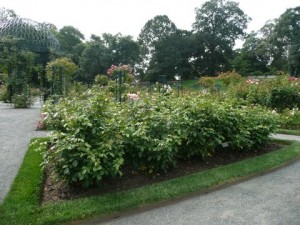How to Identify Rose Diseases Caused by Humid or Wet Weather
Posted in Gardening Tips, Gardens and Collections on September 18 2009, by Plant Talk
Black Spot and Downy Mildew Look Similar but Are Different
 |
Peter Kukielski is the Peggy Rockefeller Rose Garden Curator. |
 Few flowering plants match the beauty, versatility, or popularity of the rose. Numerous varieties offer a wide range of growth habits and floral colors. With the proper care, hundreds of rose varieties will bloom from early spring through late fall. Although there are many new varieties on the market that are highly disease resistant, some of the older varieties present a challenge, and disease control is critical for maintaining healthy roses.
Few flowering plants match the beauty, versatility, or popularity of the rose. Numerous varieties offer a wide range of growth habits and floral colors. With the proper care, hundreds of rose varieties will bloom from early spring through late fall. Although there are many new varieties on the market that are highly disease resistant, some of the older varieties present a challenge, and disease control is critical for maintaining healthy roses.
I get asked quite often to identify pests and diseases either by e-mail or by visitors to the Rose Garden. This year I got many questions regarding two specific rose diseases that are triggered by excessive humid and/or wet conditions: black spot and downy mildew.
We’ve heard the phrase “a rose is a rose is a rose.” Could one also say “a spot is a spot is a spot”? In regard to roses, the answer is “no.” These two very different types of spots can cause severe damage in different ways.
You can tell the two diseases apart by their symptoms: Black spot has circular spots and starts at the base of the plant and works its way up the plant, while downy mildew has angular spots but attacks the new growth at the top of the bush and works its way down the plant.
Of the diseases found on roses, black spot is by far the most widespread and damaging. Rose leaves often show symptoms of this disease—brown to black circular spots of one-quarter to one-half inch in diameter—in humid, hot weather.
Usually, black spot, Diplocarpon rosae, first appears on the leaves at the bottom of the plant. As symptoms continue, a yellow margin or halo develops around each spot. Several spots may grow together to form large blotches. Large yellow blotches often appear on heavily spotted leaves just before they fall from the plant. Defoliation is perhaps the most common indication of black spot. Typically, leaf-shed begins at the base of the plant and gradually spreads upward until all but the youngest leaves are lost. Heavy leaf-shed reduces flower production and plant vigor.
This past spring’s cool wet weather provided optimal conditions for a fungus called downy mildew, Peronospora sparsa. It’s a common disease of roses that occurs under moist, cloudy conditions—like the entire month of June this year! (Downy mildew usually fizzles when temperatures reach 80 degrees, but that didn’t happen in June, so it got a foothold.) Three to four days of rain with moderately warm temperatures (65°F to 80°F) will trigger downy mildew when the spores are present. The disease is found throughout the United States, Europe, and South America. All species of cultivated and wild roses seem to be susceptible.
Symptoms occur primarily on the leaves and canes. Large red to brown angular spots sometimes surrounded by a yellow halo appear on the leaves. Yellow blotches develop before the diseased leaves are shed. Elongated, discolored blotches of one-half inch to one inch in length form on the canes. Under favorable conditions, sparse, gray spore masses are sometimes seen on lesions on the lower leaf surface and on canes.
Unlike black spot, which attacks the lower foliage first, downy mildew attacks the new growth at the top (apical) of the bush and works its way down to the lower foliage. Both can devastate your plants.
If you want to control either of these with a general fungicide, check the label to make sure the product is suited for black spot or downy mildew and apply accordingly.
In the Rose Garden this year, we had no instances of either fungus on our new disease-resistant varieties (see photo of ‘Mother of Pearl’™). You may want to consider changing over to new disease-resistant varieties in your garden as well.
Read the Financial Times’ praises of Peter Kukielski’s work in bringing disease-resistant roses to the Peggy Rockefeller Rose Garden.


no i don’t think i’ll change over to those i’ll just keep my sick wild rose bushes they have a very bad case of purplish red leaves and brown spots plus the worst white mold on top as you said. they get full sun all day but the last few months its been rainy and hot and humid
im use to having the white mold but the leaf color and brown spots are new for this year i’ve never seen the brown spots before until now i usually get the white mold every year around May and June.